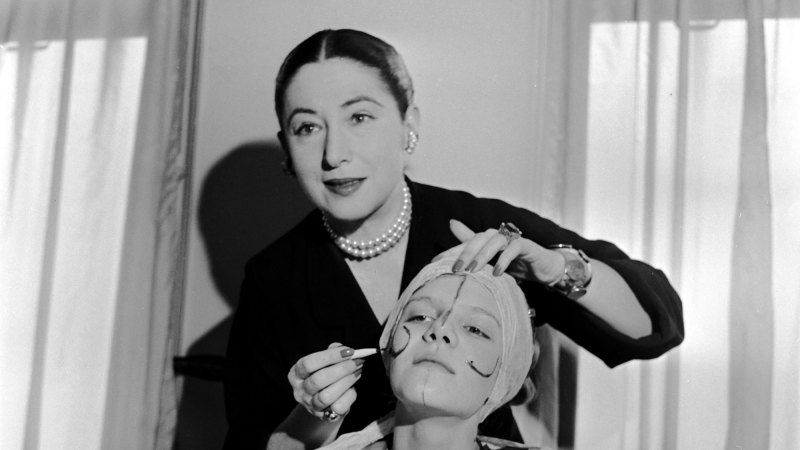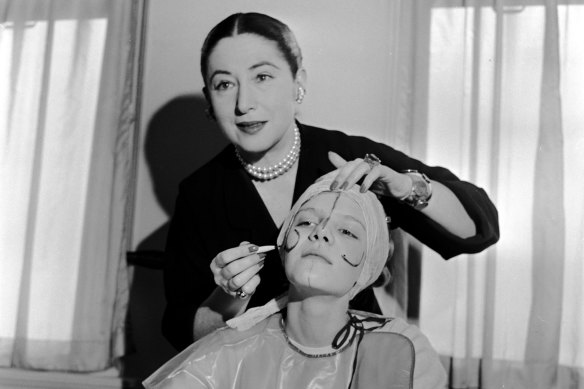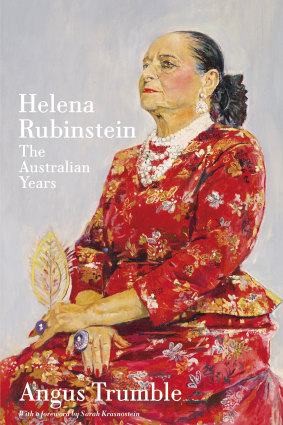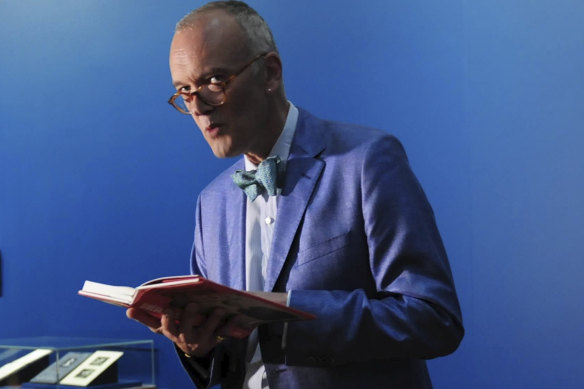Save articles for later
Add articles to your saved list and come back to them any time.
Today the beauty industry is flooded with bankable names, such as pop star Rihanna’s Fenty Beauty, reality star Kylie Jenner’s Kylie Cosmetics and actor Gwyneth Paltrow’s goop Beauty. For the first half of the 20th century there were only two names worthy of bold ink in the beauty pages – Elizabeth Arden and Helena Rubinstein.
These formidable entrepreneurs built empires on the tinted fluid foundation of skincare, without the aid of hit singles, gimmicky scented candles or bikini photographs. The closest Arden and Rubinstein came to selfies were portraits by Cecil Beaton.
Beauty expert Helena Rubinstein in 1935, after conquering Australia, London and New York, illustrating the shape of the basic lines on the face so that make-up can be applied to flatter individual contours.Credit: Orlando
The remarkable stories of these women entwined in former fashion publicist Lindy Woodhead’s gossipy War Paint (2003). That book inspired a Broadway musical of the same name, starring Patti LuPone as Rubinstein and Christine Ebersole as her rival Arden, which ran for 269 performances and featured the songs Inside of the Jar and Best Face Forward.
Former National Gallery of Australia director Angus Trumble, who died in October, only has eyes for Rubinstein in Helena Rubinstein: The Australian Years. It appears to have been love at first sight from the moment he secured Graham Sutherland’s portrait of Rubinstein for the gallery’s collection in 2016.
“In the professional life of every art museum director or curator there are acquisitions that one recalls with pride, but only a handful that one suspects may eventually be career-defining or, failing that, those for which one would like to be remembered,” Trumble writes. “Foremost among the latter for me so far is Helena Rubinstein in a Red Brocade Balenciaga Gown by Graham Sutherland.”
“Helena Rubinstein: The Australian Years” by Angus Trumble
It’s that glamorous image of an imperious and upholstered Rubinstein that adorns the cover and sets Sutherland scrambling through conflicting accounts of her past to present the facts of her Polish upbringing and her time in Melbourne, where the powerhouse business began.
There must be something in the murky water of the Yarra River: Melbourne the birthplace of Aesop, of which former hairdresser Dennis Paphitis sold 65 per cent to Brazilian beauty giant Natura for $US68 million ($103 million) in 2012, selling the rest for an undisclosed figure in 2016. It was also the home of lipstick entrepreneur Poppy King, who has launched two make-up brands.
The eldest of eight surviving daughters of Naftaly, a Polish kerosene salesman, and his wife Gitel, Helena (born Chaja) left Kraków at age 22 in 1896 for Australia, unaccompanied.
Trumble painstakingly trawls through government documents, newspaper reports and contemporary accounts to recreate the atmosphere of Coleraine in country Victoria, Toowoomba in Queensland, and post-gold rush Melbourne, where Rubinstein worked as a governess, waitress, and cared for family, before launching her own salon and skincare line.
While the solidity of facts satisfies Trumble’s authoritative detective work, equally captivating is the elusive qualities of a time and place when a single Jewish woman, initially with little English, could gain a foothold in business and lay the groundwork for a company which she would sell to Lehman Brothers for $US7.3 million in 1928, before the Great Depression.
Rubinstein would buy the business back for less than $US1 million in 1931, before building it into a $100 million company.
Author Angus Trumble during his tenure as director of the National Gallery of Australia in 2015.Credit: Graham Tidy
Along with the vivid picture of Melbourne as a city where an immigrant woman could rise from service positions to establish a flourishing chain of chic salons is the familiarity of Rubinstein’s much-copied blueprint for success.
There is the deliberate mystery Rubinstein created around the most-likely mythical medical brains behind her Crème Valaze, said to contain active herbs imported from the Carpathian Mountains, but most likely using lanolin sourced from Melbourne pharmacists Felton, Grimwade & Co.
Rubinstein also understood the power of a slogan, and in 1904 placed advertisements in Melbourne, Sydney and Brisbane with the call to moisturised arms that “Beauty is Power”. Decades later its promise of empowerment in a jar is echoed by French beauty giant L’Oréal’s 52-year-old catchcry “Because you’re worth it”. The Helena Rubinstein business was acquired by L’Oréal in 1988, 23 years after her death in New York at age 92.
There are also charming advertorials eliciting women to use Rubinstein’s cream in time for the Melbourne Cup, a technique still used by fashion brands in the weeks leading up to the first Tuesday in November.
These are the glimpses that illuminate the woman captured by Sutherland, a lifetime away from Melbourne in her suite at Claridge’s in London in 1956. When Rubinstein saw the pictures she remarked “Oh, my God! Look at me … so old! So savage … a witch!”
Sutherland, like Trumble, could see the beauty beneath the surface.
The Booklist is a weekly newsletter for book lovers from books editor Jason Steger. Get it delivered every Friday.
Most Viewed in Culture
From our partners
Source: Read Full Article



